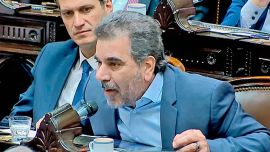Consumer prices soared 7.7 percent in March, outpacing estimates from private consultancy firms and pushing Argentina’s annual inflation rate to 104.3 percent, data from the INDEC national statistics bureau revealed Friday.
The monthly rate, the highest since last July, means that prices rose 21.7 percent in the first quarter – more than a third of the government’s annual target in its 2023 budget.
The news is another blow for President Alberto Fernández’s government, which has struggled to tackle inflation since taking office in December 2019. Economy Minister Sergio Massa has introduced sweeping price controls in recent months, but they have had little effect on runaway prices.
Most private analysts had forecast a seven percent jump for March, a month that traditionally records a high rate due to the beginning of the school year. Education recorded the highest increase of 29.1 percent, with INDEC recording rises across all educational levels.
Inflationary pressures also weighed heavily on food prices, with large hikes in meat and meat products, along with vegetables, fruit and dairy. Lettuce, for example, rose 59.5 percent in just a month. Oranges rose 43.6 percent, with tomatoes up 37.3 percent.
INDEC said that increases in food and non-alcoholic beverages overall, which reached 9.3 percent last month, had the greatest impact across all regions.
Food prices have an outsized impact on the poor, who spend a higher proportion of their daily income on them. More than 39 percent of the population in Argentina currently lives in poverty, according to government data. More than half are aged under 14, with eight percent living in extreme poverty.
Clothing and footwear recorded an increase of 9.4 percent, according to INDEC. Alcoholic beverages and tobacco rose 8.3 percent last month, with housing, water, electricity and other fuels at 6.5 percent. Transport rose 5.3 percent.
The sectors recorded the lowest increases in March were recreation and culture (4.4 percent) and communications (1.9 percent).
Government officials were quick to recognise the severity of INDEC’s figure.
“The number we see today represents the worst moment of the impact of the war [in Ukraine] on international prices and the worst drought in the country’s history. We know, it hurts us, it worries us, how it affects daily life and every family,” said Presidential Spokesperson Gabriela Cerruti on Twitter.
"We are redoubling our efforts, convinced that the way forward is to sustain the growth and order we are achieving. And we know that most of the analyses show us that this was the worst moment and that a downward trend has begun, which we hope to see reflected in the near future,” she added.
Experts see little sign of price hikes slowing in the months to come, especially with an election on the horizon in October. Private estimates forecast that April’s rate will be around 6.3 percent, with maximum forecasts of seven percent – the same level they forecast for last month.
The most recent Central Bank survey of analysts and private economists forecast an inflation rate of 110 percent for 2023.
Argentina is currently suffering from a punishing drought that has devastated the agricultural and livestock sector, the country’s biggest source of foreign currency.
According to the International Monetary Fund, gross domestic product will grow by just 0.2 percent this year.
























Comments